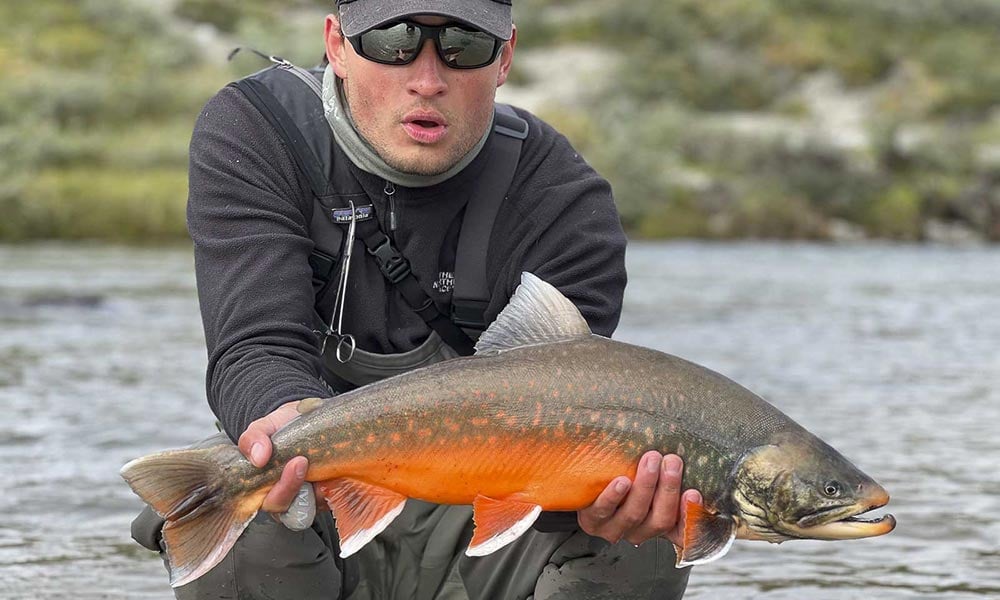Discover the best arctic char fishing destinations, guided trips, and lodge-based experiences worldwide. Explore remote waters and world-class angling with expert local hosts.

No results available
Arctic Char thrive in cold, remote rivers and lakes from Alaska to Greenland. These striking fish offer one of the wildest fly fishing experiences in the Northern Hemisphere—especially in areas where floatplanes and long hikes are the only way in.
Arctic Char (Salvelinus alpinus) are close relatives of both brook trout and lake trout, but occupy some of the most extreme environments in freshwater fishing. Found across the Arctic and sub-Arctic, they’re often the dominant predator in high-latitude systems where few other salmonids survive.
Their appearance varies widely depending on time of year and habitat. Sea-run fish return from the ocean bright and silver, while resident lake char may display deep red bellies and bold spotting. Whether caught in a coastal river, alpine lake, or tundra stream, Arctic Char deliver a powerful, acrobatic fight.
From Labrador and Quebec to Nunavut and the Northwest Territories, Canada is home to some of the world’s best Arctic Char fisheries. These northern waters host both sea-run and lake-dwelling fish, often accessed by fly-in lodges or guided floatplane camps.
Alaska’s Brooks Range and Kobuk River systems offer remote, rugged fishing for both migratory and resident Arctic Char. These fisheries often overlap with Dolly Varden but are prized for their solitude and powerful, ocean-bright fish.
Greenland’s west coast rivers are legendary for sea-run Arctic Char. Anglers sight-cast to cruising fish in clear, icy water—often while wading remote rivers just minutes from the sea.
While better known for salmon and brown trout, Iceland is home to healthy populations of Arctic Char. These fish thrive in cold spring creeks, glacial rivers, and lava-formed lakes across the island.
Lapland, Svalbard, and Finnmark host thriving char populations in high lakes and rivers. These fish are often resident, colorful, and caught on dry flies or streamers during summer’s long daylight hours.
The Taymyr and Kola Peninsulas, as well as Kamchatka, offer pristine Arctic Char fishing in some of the most remote areas of Siberia. Many rivers here see little to no angling pressure.
Arctic Char are among the most beautiful fish in the salmonid family. Sea-run fish are chrome-bright with faint pink gill plates, while spawning males turn electric orange with contrasting white-edged fins and bold spots. Their looks alone make them worth targeting—but it’s their ability to survive, migrate, and thrive in such remote, hostile habitats that sets them apart.
They’re opportunistic predators, feeding on everything from insects and sculpins to smaller char. In rivers, they strike streamers with aggression. In lakes, they’ll cruise drop-offs and shallow edges in search of food, especially during ice-out or fall turnover.
Arctic Char show incredible variation depending on season and location. Ocean-run fish are silver with a faint blue-green back and light spotting, often mistaken for salmon at first glance. Resident or spawning char shift dramatically—males often turn deep orange to red along the belly, with olive backs and creamy spots. All have a rounded tail and thick, muscular build that gives them serious power on the line.
Season timing can vary by latitude and ice melt. In some regions, fish push into rivers during warm spells; in others, lake fisheries come alive during late-season cool-downs.
FishingExplora connects you with premium Arctic Char lodges and guided trips in Alaska, Canada, and Greenland. These are true wilderness experiences—often fly-in only—offering expert guides, remote rivers, and serious fish. Whether you’re casting to chrome sea-runs or colorful alpine residents, you’ll find the right trip to match your goals.
Arctic Char and Dolly Varden are similar, but Arctic Char have deeper bodies, a blunter head, often paler spots and brighter spawning colors. Dolly Varden are slimmer with more concentrated pink-red spots and are more common in Pacific-draining rivers. Differences often depend on location and subtle physical traits.
Streamers like Egg-sucking Leeches, Zonkers, and sculpin patterns are go-to options. In some locations, char will also take dry flies and large nymphs, especially during hatches or when feeding near the surface.
Yes, many Arctic Char are anadromous, meaning they migrate between freshwater and saltwater. Unlike pacific salmon, they do not die after spawning and may return to the ocean multiple times. Sea-run char spend summers feeding in coastal waters before heading back to rivers or lakes to overwinter and spawn.
In regions with sea-run populations, char typically return from the ocean in mid to late summer—often July and August—depending on the river system and temperature. Timing is key for targeting ocean-bright fish.
Yes. Many Arctic Char live year-round in lakes, especially in Canada, Iceland, and Scandinavia. These resident fish often grow large and feed aggressively in shallow areas during ice-out and fall.
Canada’s Nunavut and Quebec regions, Alaska’s Brooks Range, and Greenland’s west coast all offer world-class trophy char fishing. These areas produce sea-run and lake-run fish well over 10 pounds in remote, scenic settings.